How to Grow Potatoes: Organic Growing, Diseases, Harvesting, Storing
People often feel that the amount of space potatoes take up to grow and the number you would need to plant in order to get a good crop is not worth the effort.
I disagree. There is nothing better than digging up, and eating your own potatoes and you can spread out the cropping season by harvesting new potatoes early into the season, rather than waiting for the crop to mature completely.
If you are short of space, you can very successfully grow potatoes in containers such as pots, buckets, stacked tires, or even plastic tall bags, as you can see below.
All my vegetables are grown organically, and so here are instructions and tips on how to grow organic potatoes.
| How to Grow Potatoes Tip: if you are growing potatoes on new land as a main crop their root systems will help break up the soil. |
Know when to plant vegetables, as well as during the month for planting by the moon.
Overview on How to Grow Potatoes:
Climate, Where and When to Plant PotatoesGood Soil for Growing Potatoes
How to Grow Potatoes using Organic Fertilizers
How to Grow Potatoes in the Ground
Growing Potatoes in Containers
How to Grow No-Dig Potatoes
Growing Potatoes in Straw
Growing Biodynamic Potatoes
Potato Yields
Harvesting Potatoes
How to Grow Potatoes and Crop Yield
Potato Pests and Diseases
Storing Potatoes
Potato Varieties
Questions and Answers on Growing Potatoes
How to Grow Potatoes: Location, Climate and When to Grow
When growing potatoes look for a sunny location, usually either in hills or ridges.Growing potatoes in hills is the more common way of growing. If planted in hills, they should be from three feet to three and a half feet apart; the distance will depend on the variety of potatoes planted.
If you are growing your potatoes in ridges or drills, these can be made from two and a half to three feet apart; although some of the earlier and smaller potato varieties may be successfully grown at eighteen or twenty inches.
How to Grow Potatoes: Seasons and Climate for Potatoes
The best climate for growing potatoes is a mild climate where daytime temperatures are between 16 - 20 degrees C.Potatoes should be planted during spring and early autumn in cool, mild regions. If you have harsh winters then plant the tubers out 4-6 weeks before the final frosts into early spring.
If you are going to grow potatoes in the subtropics in the southern hemisphere you can grow potatoes all year around if you live in a frost-free zone, but you are better off growing them only from January to August.
How to Grow Potatoes in Good Organic Soil
The best soil for growing potatoes is a light and sandy one allowing the potatoes to develop freely, without a heavy clay soil where they won't do well at all. When the soil is wet or clayey, they are very likely to get diseased and the quality of the potatoes grown in such soil is very inferior. On soils which have been long cropped and heavily manured, they also rarely succeed well. They like a soil with a pH of about 5.5.Avoid growing potatoes in very alkaline soils, or on soil that has recently been limed as the lime and the alkalinity levels will encourage the growth of scab disease. Also avoid growing potatoes in places where the area was limed in a previous season for growing brassicas.
How to Grow Potatoes using Organic Fertlizers
The less manure that is used when growing potatoes, the better the flavor; and the potatoes will also be much less affected by disease. Therefore, it is not advisable to apply a lot of manure. What you can include are barnyard and stable manures, leaves, leaf mold, peat-charcoal, and other carbonaceous substances, lime, gypsum, or plaster, (if necessary, you need enough just to get the pH levels right), and bone.Wood ash is useful in supplying potash and other inorganic substances required by potato plants; and they may be advantageously applied where the soil contains a large amount of decayed vegetable matter. The same remark will also apply to lime, which is useful in destroying slugs and other vermin, which attack the tubers. Crushed bone, and super-phosphate of lime, are best for humid soils.
How to Grow Potatoes in the Ground
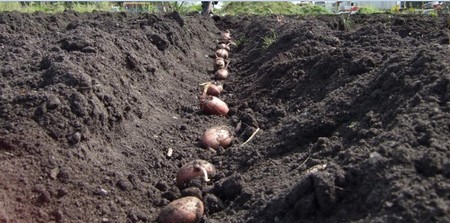
Planting Seed Potatoes
Or, you can do what I do, when your potatoes start growing strong 'eyes' take them, cut them up with a good portion of remaining flesh for food, and plant. You will read elsewhere that this is not the correct way to grow potatoes as you could end up with diseased plants, but really in all the years that I have been doing this, I have never had an issue with disease.
Some will argue that when growing potatoes it is better to leave the potato whole rather than to cut it up, but this is not so, and many get a better cropping if the tubers are indeed cut and planted rather than just planted whole.
| How to Grow Potatoes Tip: If you are going to cut up the potato leave the potato pieces out overnight with the cut sides drying out overnight at room temperature before planting out. |
The size of the potato tubers is important. Large tubers, are preferable, for the following reasons: In all plants, large buds tend to produce large shoots; and small or weak buds, the reverse.
Now, the eyes of potatoes are true buds, and in small tubers they are comparatively weak: they consequently produce weak shoots, and the crop from such is inferior to that obtained from plants originating from larger tubers, furnished with stronger eyes; and this conclusion has been justified by the results of actual experiments.
Some however, like to use whole tubers, keeping the 2 strongest eye shoots on the tuber and rubbing off the rest with the thumb. Make sure that the tubers have not been placed in too warm an environment where the shoots are tall and spindly as these will not produce good plants.
Plant 10-12 inches deep with 2 - 3 and a half feet between rows, depending on whether you will grow your potatoes in ridges or in hills.
From a 3 kg (6.6 lbs) bag of seed potatoes you will get 50 - 60 plants which is more than enough for the average family.
How to Grow Potatoes and Hilling the Soil
When growing potatoes, watch for the shoots and as soon as the plants are above the surface, heap the soil around the shoots, taking care not to damage the plant. This should be done once the plants are 8 inches high, the earth should gradually be drawn into hills, or ridges, at each successive hoeing, and the side-roots should be encouraged to spread. Bank the soil every 2-3 weeks.This is done for several reasons.
- In the early days, banking your potatoes will protect the young plants from frost.
- Later on, it prevents the sun from getting to them, which will cause your tubers to turn green. Green potatoes are highly poisonous and only fit for the compost heap.
- Hilling potatoes helps protect your plants from being attacked by the caterpillars of potato moths.
- Lastly, when growing potatoes like this, it will help keep
the
weeds down.
How to Grow Potatoes with Proper Watering
Water your potatoes well in dry weather, because if you don't you can end up with split or cracked tubers. Don't over-water because if you do, your tubers will rot. Therefore, getting the balance right in watering, will be the key to your success in growing potatoes successfully.The most critical time to get the watering right is when your tubers are forming at 6-8 weeks after planting. This is when your soil should be kept moist until just before harvesting. The soil should feel damp and cold, and the soil should stick to your fingers if you place them in the soil.
Forcing Potatoes
Forcing potatoes should start three to four weeks before the growing season for planting in the open ground. The earliest varieties should be chosen for the purpose, selecting whole tubers of medium size, and placing them close together, in a single layer, among half-decayed leaves or very light loam, on the surface of a moderate hot-bed.When the shoots are about two or three inches, and the weather has become sufficiently mild, the potatoes should be carefully taken out, and divided into sets; in the process of cutting up the tubers, avoid injury to the small fibrous roots, and also to the growing shoots.
Growing Potatoes in Containers and Bags
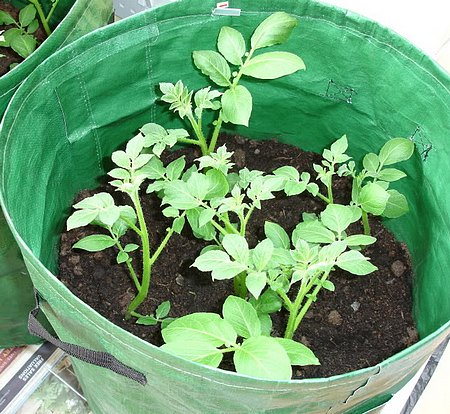
Growing potatoes in containers such as these bags.
Potatoes can be grown in a variety of containers from bags, buckets, commercial pots to old car tires. As long as you continually build the soil up, pototoes can be grown in just about anything. As a result, if you live in an apartment and have a balcony you can still grow your own potatoes. Just make sure that the container has weep holes so that the soil will drain well and that there is at least a depth of 1 foot (30 cm) . To encourage good drainage you can put some coarse gravel as a base in your containers.
Growing potatoes in containers does mean a little extra care with the soil. Fill the bottom of the bag or container with compost or potting mix, until about a third full, then lay the potatoes in, and top up as required as they grow.
Because potatoes are formed under ground, the more of the plant stem that is covered, the more potatoes are likely to be produced. However, this has to be done slowly, as the plants grow. So heap up the soil around the stem of your container grown potatoes, just as you would if you were planting potatoes out in your vegetable garden.
Because the soil can dry out a lot quicker in containers than if you were planting potatoes in the ground, it is wise to add a mulch to around the plants. Composted grass clippings, sugar cane, lucerne or pea straw can all be used. Keep the mulch away from the stems.
Your potato plants don't need fertilizing while they are growing, but they should be given very rich soil to grow in from the beginning. You can water in your potatoes when you first plant them out with liquid seaweed.
Howto Grow Potatoes the No-Dig Way
Select a well-drained spot in the garden for you to plant your potatoes and then place sheets of newspaper in layers 6 - 8 sheets thick, making sure that you have wet them first. Place the potatoes on the newspaper, with the shoots facing up, and spacing them at least 1 foot (30 cm) apart.Cover the potatoes with many thin layers of compost, green waste, lucerne or pea straw, mixed with some well composted farmyard manure, blood and bone and leaf litter. Make sure that you have covered the potatoes to a depth of 20 cm (8 inches).
As the potatoes begin to shoot,and as the material begins to rot down, add more composted material. After about 4 weeks, cover the potatoes with a final layer of mulch.
Growing Potatoes in Straw
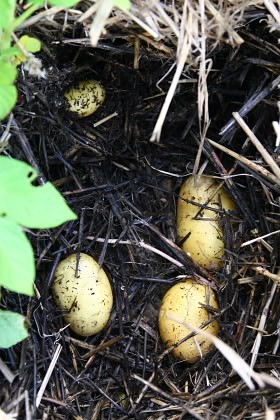
This way of growing potatoes is really based on the no-dig method but instead of using green waste, lucerne and the like, you use just straw to cover your potatoes.
Dig a trench in soil that is rich with well composted matter. Make sure that the trench is a foot deep and about 5 inches wide. Then place your tubers at the bottom of the trench. The eyes should be facing up.
Placing the tubers in about an inch of the soil, take straw and lay it over the potatoes to a depth of about 6 inches.
As the potato plants start to appear above the straw cover them over with 4 inches of straw.
You will need to water the straw so that it is moist but not soggy.
Growing potatoes in straw acts as a mulch for your tubers as well as keeping the sunlight out to prevent them from going green. It is also an excellent way of growing no-dig potatoes so that when it is time to harvest them you can just remove the straw choose the biggest ones and then replace the straw until the next time.
Growing Biodynamic Potatoes
According to Maria Thun, who is the expert on biodynamics, she grows her potatoes by preparing the soil a year in advance. Compost and well-rotted manure is worked into the soil in the fall. At the same time, a cow-pat pit preparation is sprayed onto the soil. After 4 weeks, and no later than mid-November the furrows and then ploughed. This allows the soil organisms to work and then be left undisturbed to do their work.In spring the soil is then cultivated again and a horn manure preperation is sprayed onto the soil. The potato tubers are then planted on root days. During that time, the area is hoed twice during the growing season to get air into the soil which again is done during root days. At the same time, a silica preparation is applied.
After 4 weeks of growing, soil is hilled up around the plants.
How to Grow Potatoes: Harvesting Potatoes
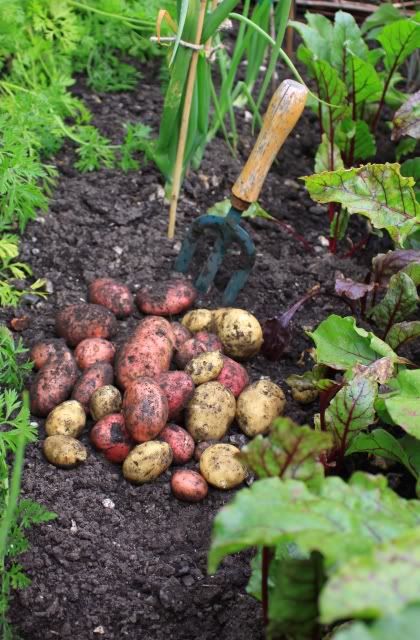
Harvesting Potatoes
The practice of partially removing the soil from about the roots, and gathering the largest tubers, leaving the smaller ones, with the expectation that they will get bigger is not a good idea, as the potato will not take kindly to the invasion. It is far better to take the little potatoes and leave the bigger tubers to carry on growing.
Harvesting potatoes takes place after the plant has flowered, the leafy parts turn yellow and the plant tops start to die down. If you find that the weather is good, there is no fear of disease and the ground moist the tubers can stay in the ground another week before you start cropping, as they will increase in size during this period.
Late potato growing varieties usually make up the main crop, and it's these that require most care when digging up and storing. So long as the plants are green, the potatoes should be allowed to remain in the ground; as this is quite indicative that the tubers are not fully mature.
Just take care when digging up your potatoes. Many a potato has been ruined by an impatient gardener using a spade. It is better to use a fork and try and lift the soil a little way away from the main plant so as not to damage the tubers.
If you do end up damaging the tubers these should be eaten first.
How to Grow Potatoes: Crop Yield
Knowing how to grow potatoes is easy if you can get past the blight and other pests and diseases. But how many potatoes will you get from each plant? Well this differs greatly from one potato variety to the next. However, you can expect between 1-2 kilos of potatoes per plant for early varieties, and 3-4 kilos of potatoes from your main crop.There are some who practice removing the flowers from the potatoes as soon as they appear in order to improve the size and number of their potato crop. As soon as the flowers appear, remove them and the plant will stay green for longer allowing the potatoes to continue to grow.
How to Grow Potatoes: Garden Pests and Diseases
When growing potatoes you can find that your crop will be attacked sometimes by wire worms and slugs.When learning how to grow organic potatoes any pesticides and insecticides will have to be totally natural. Many people think that by growing organic potatoes means just leaving them for nature to takes its course and not spray at all. This is foolish, as you will loose a lot if not all of your crop if you don't. Organic growing of potatoes still means that you will need a spraying program of some sorts.
Therefore, these garden pests can be eradicated using organic methods. However, by planting early varieties, you can also avoid a lot of these problems.
Potatoes are also very prone to blight which can seriously damage the crop, especially if you want to store potatoes for a long time. Instead of spraying with copper-based sprays, try planting potato varieties that are resistant to blight, such as Cara, Estima, Romano, and Maris Peer.
To protect your potatoes against blight you can spray the plant with cold stinging nettle tea. Once the second pair of leaves has emerged, spray them with stinging nettle tea in the late afternoon. Then, every 9 days spray them in the early morning with a spray of yarrow, camomile, dandelion and stinging nettles in that order. This is a biodynamics method that is said to be very effective.
Natural Spray Recipes for Potato Blight
For yarrow, dandelion and camomile add 1 gram (0.04 oz) of dried blossoms to 10 liters (2 gallons) of water. Boiling water is poured over the blossoms and steeped for 15 minutes. Strain and wait until it is cold, and then spray.For stinging nettles add 5 grams (0.2 oz) of dried leaves to 10 liters (2 gallons) of water. Boil briefly and then strain after 15 minutes. Allow to cool before using.
If you do get potato blight, remove and destroy the damaged stems at once to prevent the spores from spreading into the soil or on to the tubers. The resulting crop is then usually perfectly usable.
Potato scab often comes about by using non-certified seed potatoes, and is worse in alkaline soils under dry conditions. To minimize this risk, buy certified seed potatoes, make sure that the pH of your soil is not above 6 and avoid growing potatoes or other solanaceous crops such as tomatoes, capsicums, eggplant and chilli in the same bed season after season.
If scab disease is a problem choose potato varieties resistant to scab disease such as King Edward (although susceptible to blight), Maris Peer, or Arran Pilot.
Don't grow potatoes in soil where peas, oats or barley have been planted as this increases the chance of scab. However, if potatoes follow a crop of soybeans, this drastically reduces the chance of scab.
Leaf-eating beetles can do a lot of damage to the leaves of the plants. If they attack your crop in the early growing stages, they will also affect your harvest . However, if the beetles attack later on the effects are less severe. Control the beetles by squashing by hand, or by applying soap and pyrethrum sprays.
The potato beetle is another great pest to these plants. If you mulch heavily with straw, just after the plant emerges from the soil, it will help reduce the issue of the potato beetle by 90%.
How to Grow Potatoes: Storage
When growing potatoes in bulk, you will need to think about how and where you are going to store them. The most important thing is making sure that you don't expose them to light. Again, if you do they will become green and poisonous.Therefore it is important that potatoes are kept in a dark spot on the same day that they have been dug up. Never let potatoes dry off in the sun after they have been removed, but they should be dry before they are stored. The vegetables should be stored in boxes in a dark cellar, free from rodents.
When storing potatoes in your kitchen, never store potatoes near onions, as the gases they each emit will cause the degradation on one another.
The ideal temperatures for storing potatoes is 40 - 45 degrees F (4 - 7 degrees C. ) with 90% humidity. Storage temperatures below 38 degrees F (3 degrees C. ) tend to make potatoes sweet through a change of some of the starch to sugar, and this is not what you want.
If you find that your potatoes have been stored at a temperature lower than optimal then you can rectify this by keeping them at a temperature at 70 degrees F. (21 degrees C.) for about 2 weeks before using.
Now that you know how to grow potatoes, you may be interested in some easy potato recipes once you have made your first harvest.
My Favorite Potato Varieties
Not all potatoes are equal. Some varieties have been developed for potatoes that you can mash, fry or roast or both. Therefore, it is good to grow several varieties that will provide you with the type of potatoes that you use most in your kitchens. However, there are some potato varieties that are good for growing and eating and here are some of my favorites:- Kipfler. I like these small, finger-like potatoes to roast along with my other vegetables. I don't peel them either, but just give them a good old scrub and they are good. They are also good steamed and used in salads.
- Blue congo for its unusual color and long storage. Certainly a talking point at any dinner party and good for boiling, mashing and baking.
- Desiree for its lovely pink skin and creamy centers, and because it is such a versatile potato. The Desiree can be used for boiling, mashing and frying.
- Pink Eye is also a favorite as it is great to grow for salads as it has a rather waxy texture and therefore holds its shape very well when boiled.
- King Edward is one of the best all-round potato varieties. King Edward potatoes grow well in containers and is a good all rounder for steaming, baking, frying and roasting. However it is also one of the best potato varieties to make gnocchi!
- Pontiac again is another all-round variety, but as they are difficult to peel they are best cooked with the skins on. They are very similar looking to the Desiree as they also have a pink/red skin.
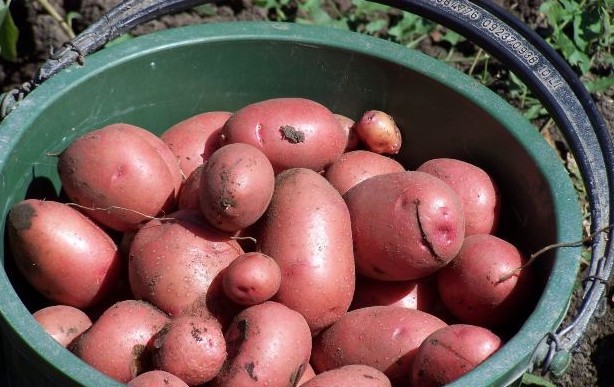
Questions & Answers on Growing Potatoes
Q. Should I save some of my potatoes for seed?A. No, unless you are saving seed of an heirloom variety not commercially available. Saving your own seed potatoes can lead to a buildup of viruses and diseases. Whenever possible, plant seed potatoes certified to be free from certain viruses and diseases.
Q My potato plants flowered and formed green fruits that resemble small tomatoes. What are they?
A. These small seed balls are the fruits that contain the true seeds. They are not edible. Except for breeding purposes, growing potato plants from the true seeds in these fruits is a troublesome and unrewarding exercise.
Q. What causes green skin on my potatoes?
A. The green areas on tubers develop where the potato was exposed to the sun. This condition occurs when the potatoes were not planted deeply enough or not covered with straw. The green portions taste bitter because they contain a moderately poisonous alkaloid. These green areas should be cut off and discarded. Exposure of potato tubers to fluorescent light or sunlight causes greening during storage.
| How to Grow Potatoes Tip: Take your green potatoes and boil them up in some water. When cooled use it neat as an effective insect repellent for spraying on plants. |
Q. How should potatoes that are cut into seed pieces be cured?
A. They can be cured by leaving them overnight before planting at room temperature. You can leave them up to a week like this before planting out.
Q. Can I make chips from homegrown potatoes?
A. Yes. Almost any potato variety can be used to make chips when the potatoes are freshly dug and starchy. Commercial chips are made from selected varieties that are naturally high in solids, carefully handled and properly stored to preserve starch and avoid buildup of sugars. Chips made from potatoes stored at low temperatures for long periods are brown or have a dark ring because they contain excessive amounts of sugar.
Q. Can I use grocery store potatoes for planting?
A. You can, I have done in the past, but you have to be careful as you are not guaranteed success. They may have been treated with a sprout retardant, in which case, they will not grow. Even if they are sprouting, they have not been inspected and certified free of disease. While results occasionally may be acceptable, the risk of introducing a nematode, disease, or other pest is much higher than from quality-certified seed potatoes.
Q. How many pototo plants do I need to plant?
A. The number of potato plants you plant really depends on how many people there are in your family, how many potatoes you eat a week and how much space you have, as potatoes can take up a lot of space in your garden. Each plant will produce about 1-2 kilos, depending on the variety of potatoes you plant. So this is a yard-stick to go by.
Some Countryfarm Lifestyle Tips on Cooking Potatoes
|
Did you find this page helpful?
Sharing is a way of saying, "Thanks!"
Follow Us and Keep Up to Date
Books on How to Grow Potatoes
You can Add your Own Comments on Growing Potatoes Here!
We have lots of pages where you can contribute to throughout this homesteading website. We love hearing from our readers, and hope you will be one of those we hear from too. Please feel free to add your own comments on growing potatoes here.
Leave a Comment
Do you have anything that you would like to add after reading this page? We would love to hear your thoughts. If you can add additional information to what has been written here you will be adding value to the website! No need to have any special skills - just type and submit. We will do the rest!
Other Comments
Click below to see comments from other visitors to this page...
red potatoes Not rated yet
My red potatoes are now a good size and I am digging some up now.
However, I am finding that the new potato is sprouting with smaller potatoes
from …
Growing Potatoes from Potato Eyes Not rated yet
I planted some potato eyes last year just for fun and low and behold I had potatoes. But, when I planted again this year a lot of the smaller ones came …
Taking Seaweed from the Beach Not rated yet
I'm very fortunate where I live. There are lovely views, beaches, good fishing etc. It's great when we've had a bit of stormy weather when I can go down …

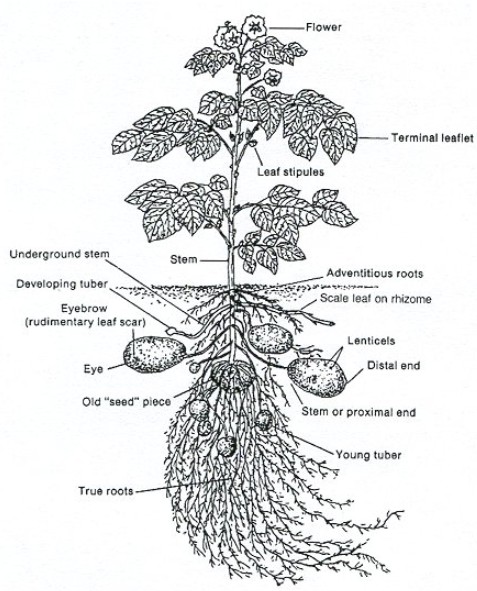
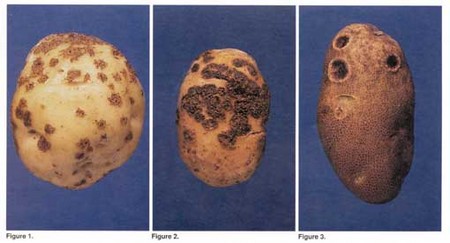








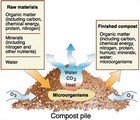




New! Comments
Do you have something of value to add? Leave me a comment in the box below.